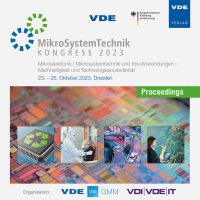Design and fabrication of a metalens for shaping the light of quantum dot based light emitting diodes
Konferenz: MikroSystemTechnik Kongress 2023 - Kongress
23.10.2023-25.10.2023 in Dresden, Deutschland
Tagungsband: MikroSystemTechnik Kongress 2023
Seiten: 6Sprache: EnglischTyp: PDF
Autoren:
Grossmann, Toni D.; Kuhn, Harald (Fraunhofer Institute for Electronic Nano Systems ENAS, Chemnitz, Germany & Center for Microtechnologies, Chemnitz, Germany)
Moebius, Martin; Hartmann, Susanne; Meinecke, Christoph Robert (Center for Microtechnologies, Chemnitz, Germany)
Martin, Joerg; Reuter, Danny (Fraunhofer Institute for Electronic Nano Systems ENAS, Chemnitz, Germany)
Inhalt:
The use of quantum dot technology enables the realization of efficient, thin-film (~200 nm thickness) light sources on rigid or flexible substrates. Quantum dot based light emitting diodes (QD-LEDs) offer a high spectral color purity, high light density, long lifetime, a high chemical and temperature stability as well as stable operation at low power. Depending on the choice of quantum dot material and their size different QD-LEDs for the visible or near-infrared spectral range with narrow band emission can be realized and are therefore suitable for the use as light sources for spectroscopy. In general, QD-LEDs emit nearly homogenously in half space (Lambertian source), so that most light is not usable for directed lightning, necessary for most applications. Hence, it is desirable to collimate/focus the emitted light to reduce the losses and to improve the radiation characteristics. To solve these problem optical lenses can be used. However, such spherical lenses have a large overall height or requires multiple combined lenses to achieve the desired optical properties, thus preventing further miniaturization opportunities and cost savings. A novel approach to replace conventional bulky optical lenses or lens systems is the use of so-called optical metalenses. A optical metalens is a planar optics, which is made of two-dimensional and periodic arranged subwavelength structures to implement, for example, a parabolic phase profile that makes it possible to influence the propagation of light. In the present work we have designed and fabricated a concentric metalens with a lateral dimension of 2 mm x 2 mm and a focal length of about 20 mm. The metalens was designed to operate in the visible spectral range and tuned to a peak wavelength of a QD-LED, which operates at 620 nm. CST Microwave Studio was used to determine the phase shift caused by each individual subwavelength structure, on which the realization of the parabolic phase profile for the implementation of a metalens with a focal length of 20 mm at a target wavelength of 620 nm was based. The metalens was realized by depositing 600 nm silicon nitride (Si3N4) on a 500 µm thick glass wafer followed by nanostructuring using ebeam lithography (Vistec SB252) and subsequent Si3N4 plasma etching. The focal length and the full width at half-maximum (FWHM) of the realized metalenses were characterized using a tunable laser (SuperK Compact, NKT Photonics) and a CCD camera (CS235CU, Thorlabs). The realized metalenses show a focal length that is in the range of 22 mm and have a FWHM of about 17.64 µm. The functionality of the realized metal lenses in combination with a QD-LED emitting at 620 nm could be proven in an optical setup.


